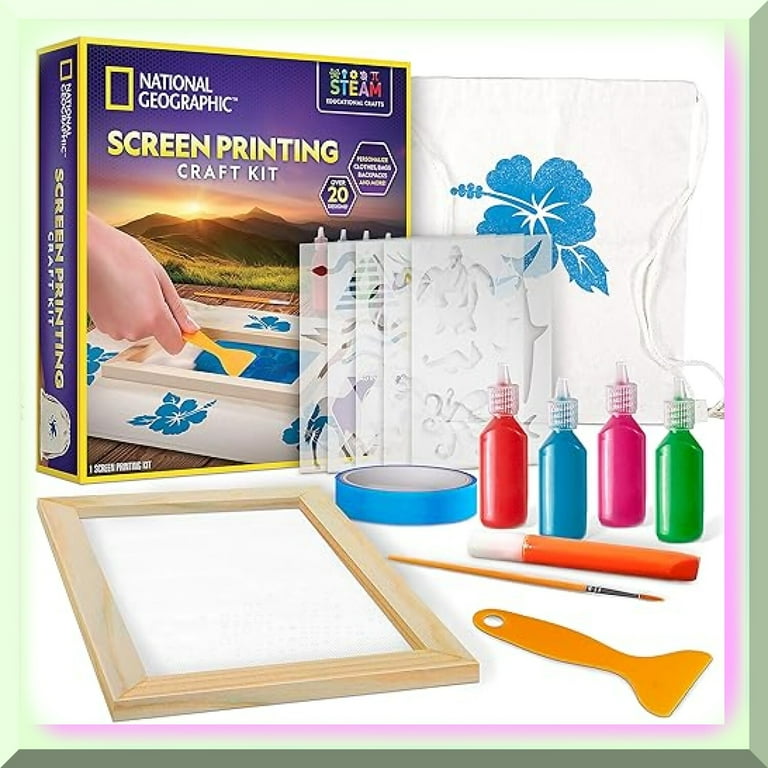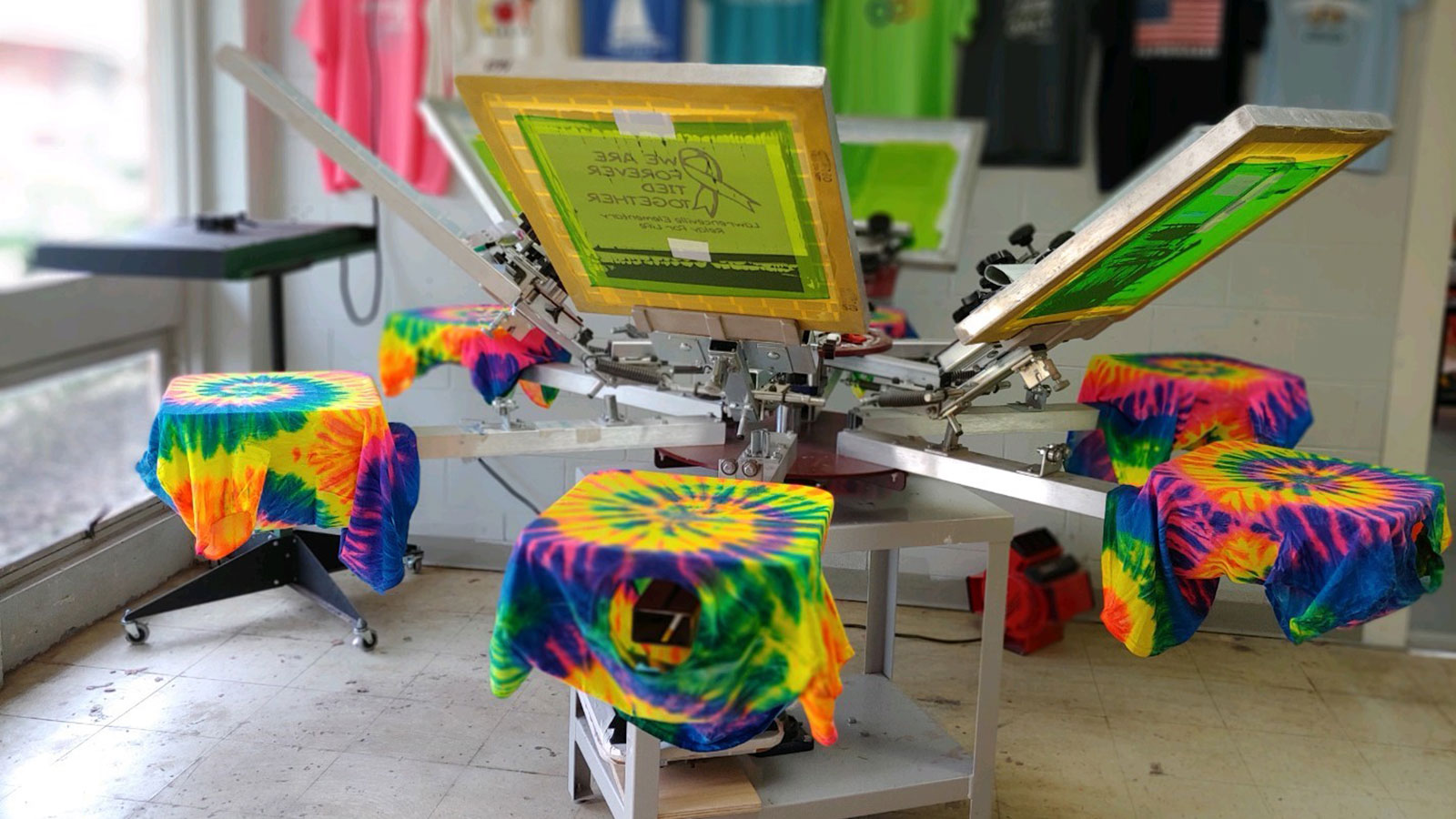Display Printing Uncovered: Everything You Required to Know Concerning T-Shirt and Garment Printing Strategies
If you have actually ever questioned exactly how those vivid designs end up on your favored tees, you remain in the appropriate place. Screen printing is an interesting technique that combines art with method, offering endless opportunities for creative thinking. Comprehending the basics, from devices to ink options, can considerably influence your outcomes. All set to check out the crucial elements that make screen printing an art type? Let's discover the information that can raise your jobs.
The Fundamentals of Screen Printing: How It Functions
When you dive right into screen printing, you'll discover it's both an art and a science. At its core, screen printing involves creating a pattern, or display, that enables ink to pass with just in particular locations.
Placement the screen over the material, after that use a squeegee to press ink through the screen onto the garment. Each step is vital, and mastering them will boost your display printing skills, changing simple garments into one-of-a-kind, expressive items.
Kinds Of Screen Printing Methods
As soon as you understand the essentials of screen printing, it's time to explore the various strategies that can boost your styles. One prominent approach is traditional screen printing, where ink is pressed via a stenciled display. This technique is fantastic for vibrant, vibrant colors. There's water-based ink printing, which offers a softer feel and is environmentally friendly, however it calls for a various approach to healing.
If you're aiming for great information, take into consideration discharge printing. This method eliminates dye from the material, leaving a soft, vintage look. One more option is plastisol printing, known for its toughness and dazzling shades, making it a favored for several brand names. Finally, experiment with halftone printing to create slope impacts and elaborate designs. Each technique has its unique beauty, so don't be reluctant to try them out to locate what suits your design best!
Essential Equipment for Display Printing
To attain magnificent outcomes in display printing, having the right equipment is fundamental. You'll need a strong display printing framework, which holds the mesh that transfers your layout onto the garment. Next off, spend in top quality squeegees; these are necessary for applying ink equally across the display.
Selecting the Right Inks and Products
When selecting inks and products for display printing, you require to think about the kind of ink that works ideal for your task. Consider textile compatibility to ensure your styles look wonderful and last lengthy. Likewise, discover environment-friendly ink choices to make your printing process a lot more sustainable.
Sorts Of Screen Inks
Choosing the right screen ink is vital for achieving vibrant, durable prints that fulfill your task's requirements. There are a number of kinds of screen inks to examine. Plastisol ink is popular for its adaptability and ease of use, offering outstanding shade opacity on dark textiles. Water-based ink, on the various other hand, provides a softer feeling and is green, making it suitable for those seeking to reduce their environmental effect. Discharge inks remove color from the material, resulting in a soft, vintage appearance however require certain handling. Finally, specialty inks, such as metallic or glow-in-the-dark, can add special results to your layouts. Evaluate your task requirements and choose the ink that straightens ideal with your preferred outcome.

Material Compatibility Factors To Consider
Understanding fabric compatibility is vital for achieving high-quality screen prints, especially because different materials react distinctively to various inks. When choosing inks, consider the fabric type-- cotton, polyester, or blends. For cotton, water-based inks function well, supplying gentleness and breathability. Polyester, on the other hand, usually calls for plastisol inks for far better bond and lively colors. You might need to use a mix of both kinds if you're printing on blends. Constantly examine your inks on example material to guarantee they adhere properly and keep shade integrity. In addition, bear in mind that material weight and texture can influence the last outcome, so selecting the appropriate ink and product combo is vital for your task's success.
Eco-Friendly Ink Options
Eco-friendly inks are becoming a prominent selection for screen printers who want to lessen their ecological influence while maintaining quality. When selecting inks, think about water-based inks, which are much less over at this website damaging and much easier to cleanse up contrasted to typical solvents.
In addition, search for inks made from sustainable resources, such as soy or vegetable-based choices. By selecting the best inks and products, you'll not just produce sensational styles however also add to an extra lasting printing process. Make the button, and your prints will certainly show your commitment to the environment!
Preparing Your Style for Display Printing

Submit Layout Requirements
To guarantee your style looks lively and sharp on fabric, you'll require to pay attention to submit format needs for screen printing. Beginning with vector data like AI or EPS, as they can be scaled without shedding high quality. If you make use of raster images, choose high-resolution data, such as TIFF or PNG, preferably at 300 DPI. Avoid utilizing JPEGs, as they can shed clarity when resized. Make certain your design has a clear background to avoid undesirable white sides on your prints. Ultimately, keep color settings in mind; CMYK is common for display printing, so transform your RGB develops accordingly. By adhering to these standards, you'll set your art work up for a successful print.
Color Separation Strategies
Color splitting up is an essential action in preparing your layout for display printing, and mastering it can greatly enhance your print quality. You'll require to damage your layout into individual colors, as each shade calls for a different display during printing. This accuracy not just assures accurate shade representation yet likewise enhances the printing procedure.
Resolution and Dimension
Attaining the very best lead to screen printing begins with assuring your design has the right resolution and dimension. Preferably, your art work ought to be at least 300 DPI (dots per inch) for sharp, clear prints. Your last item might look pixelated and unprofessional. if you utilize reduced resolution.
When it comes to dimension, take into consideration the dimensions of your print location. Design your artwork to match the final print size, click for more info ideally developing it in the real dimensions you'll be printing. This way, you'll prevent any kind of unforeseen scaling concerns.
Constantly inspect your style in both vector and raster formats. Vector graphics can be scaled without shedding top quality, making them suitable for screen printing. Preparing properly will guarantee your design looks amazing on every garment!
Step-by-Step Screen Printing Process
Screen printing is a dynamic process that allows you to produce vibrant designs on different click for source surface areas. To get going, you'll need a display, solution, and your chosen ink. Prepare your screen by cleaning it thoroughly. Next off, use the solution uniformly and allow it dry in a dark area. Once dry, expose your display to light with your layout positioned on it, which will certainly solidify the solution where the light hits, developing a stencil - screen printing kit.
After cleaning out the unexposed solution, your screen is all set. Set it up on your printing surface and align your garment under it. Pour ink onto the display and utilize a squeegee to press the ink through the pattern onto the textile. Raise the screen meticulously and allow the print dry. Treat the ink using warmth to assure durability. That's it! You've effectively screen published your layout.
Tips for Effective Screen Printing Projects
While you're diving right into your display printing tasks, bear in mind that prep work is essential to success. Start by gathering all your materials-- inks, garments, mops, and displays. A clean work space assists stop undesirable mistakes, so clean prior to you begin.
Next, confirm your artwork is high-resolution and effectively sized for your garment. Evaluate your screen for correct exposure and tidy it extensively to avoid smudges. When blending your inks, follow the producer's standards to achieve the right uniformity.
During printing, use even stress with your squeegee for regular results. Do not hurry; take your time to validate each print fulfills your requirements. After printing, let your garments dry completely before handling or packaging them.
Lastly, always maintain a sample of your benefit future reference. By doing this, you can evaluate your progression and enhance your methods in time. Delighted printing!

Often Asked Inquiries
The length of time Does It Require To Set up a Screen Printing Job?
Establishing up a display printing job normally takes around half an hour to an hour. You'll prepare the displays, mix inks, and change the press. The moment differs based upon complexity and experience, so remain arranged!
Can I Publish on Different Material Types Making Use Of the Exact Same Strategy?
Yes, you can publish on various textile types utilizing the very same technique, but you'll need to adjust your settings and inks. Some textiles absorb ink in a different way, so experimenting guarantees the finest results for each product.
What Prevail Errors to Stay Clear Of in Display Printing?
When display printing, avoid usual errors like using the wrong ink, disregarding appropriate exposure times, or missing pre-press checks. Always test your arrangement and keep clean screens to assure high quality results each time.
Just How Can I Appropriately Clean and Keep My Screen Printing Tools?
To appropriately clean and preserve your display printing equipment, you need to regularly wash screens with ideal solvents, inspect mops for wear, and ensure all tools are stored dust-free and dry. Consistency enhances and stops costly fixings performance.
Is Display Printing Environmentally Pleasant Contrasted to Other Techniques?
Screen printing can be a lot more eco-friendly than various other methods, especially if you make use of eco-conscious products and water-based inks. By choosing sustainable materials and techniques, you decrease waste and lessen your influence on the planet.
Screen Printing Uncovered: Whatever You Required to Know About Tee Shirt and Garment Printing Strategies
At its core, display printing includes developing a pattern, or display, that allows ink to pass through just in specific areas. Setting the display over the textile, after that make use of a squeegee to push ink through the screen onto the garment. One prominent technique is typical screen printing, where ink is pushed through a stenciled screen.When choosing inks and materials for screen printing, you need to take into account the type of ink that works finest for your job.